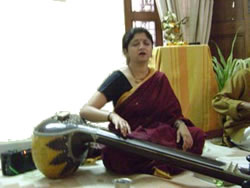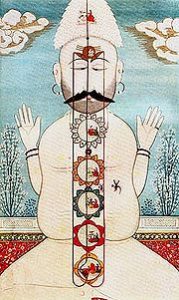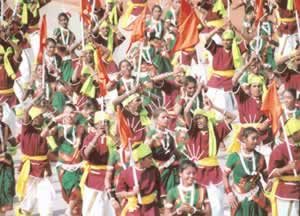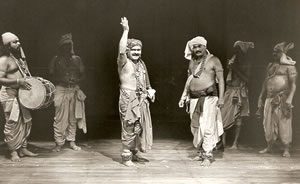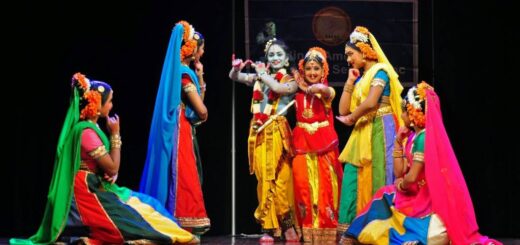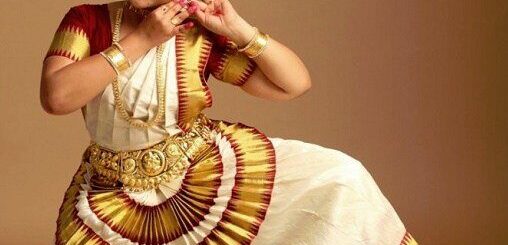Discourses on Music / Prateeksha Sharma
Music- A Path to Wholeness
The author practicing on the Veena
Music is the essence of life, spirit and creation. To understand our musical selves is the beginging of our journey to becoming whole from the disjointed, often scattered selves we become as a result of socialisation and accularization. When we turn to music we unknowingly turn to mother nature who coded music into us even while we were being formed from the various elements, and in this turning we connect ourselves to our inner deeper selves- sometimes which does not reveal itself to us in our mechanisitic daily survival rigmarole. Wordsworth, in his autobiographical poem, The Prelude, in a reflective passage of Book 1 says,
Dust as we are,
the immortal spirit grows
Like harmony in music
-William Wordsworth
Though we come from the five elements and return back to them, the spirit creates newer vistas for itself and continues to scale heights that the body alone cannot scale. The spirit grows while the body withers. Such is nature’s playground. And the more the spirit grows, greater is the harmony it produces- within itself and with the world around. Such is music; such is life. Music is a reflection that mirrors every aspect of life, within its infinite folds, shades, hues and contours.
According to Yaksa, who codified the explanations for the word sangīta, around 500 B.C. the word sangita is explained by its symbolic substitute word bharata: bha from bhava(emotion), ra from raga (the modal-scalar framework for melody), and ta from tala (the rhythmic and metric structure). The specific Bharata invoked in the definition of sangita is the legendary sage who is said to be the author of the Natyashastra, the most important early treatise on music and theatre[i]. This explanation of music clearly portrays how from time immemorial the Indians have known about the inextricable link between emotions, melody and rhythm.
The word ‘music’ etymylogically comes from the ‘muses’- Greek goddesses who inspired poets, painters, musicians etc. The word traces its history via Old French musique and Latin musica, to Greek mousike, a noun use of mousikos ‘of the muses’, an adjective derived from mousa ‘muse’- John Ayto[ii] aptly comments :
“the specialisation of the word’s meaning began in Greek- first to ‘poetry sung to music,’and subsequently to ‘music’ alone.
According to the Greeks, Apollo was the patron god of music, dance and poetry. He earned the epithet of ‘musagetes’ –the leader of the muses[iii]. Interestingly Apollo was also the patron god of the healing arts, medicine and archery (Recall the number of hospitals and clinics named after him) Thus, music became synonymous with healing from the dawn of time.
[i] Rowell, Lewis (1992) first Indian edition 1998. Music and Musical Thought in Early India. New Delhi: Munshiram Manoharlal Publishers Pvt.Ltd.
[ii] Ayto, John (1997), Bloomsbury Dictionary of Word Origins, Delhi: GOYLSaaB
[iii] Mythology: myths, legends and fantasies, (2003) UK: Grange Books
Chakras and Sound
Late 18th century A.D Kangra school Painting of Yogin with six chakras
In addition to our visible, gross body we also have the subtle body in the form of an energy field around it. The physical body contains the most dense and therefore visible energy. This energy continues forming layers of energy fields around the body which are not usually visible to the naked eye. This magnetic field energy that surrounds the body is called “aura”. The aura is created by the energy of the chakras- the psychic, whirling energy processing centres of the body. According to yogic theory, there are approximately 72,000 nadis, astral nerve tubes, the most important of which is the sushumna, the astral body counterpart to the spinal cord. On either side of it are two nadis known as ida and pingala, which correspond to the left and right sympathetic cords in the physical body[i]. There are six points in the body where these three nadis intersect and these points also correspond in location to the major nerve ganglia (cervical plexus, solar plexus, sacral plexus and so forth) located along the spine in the physical body. In healthy people, the chakras are vibrant and spin with vigour, while in those who are not well the chakra petals are dull and spin sluggishly, says the American Hindu priest Thomas Ashley-Farrand[ii]. Interestingly, these chakras respond to the sound of Sanskrit, a fact which was noticed by ancient Indian mystics with “second sight”, the ability to see clearly in the subtle realm. These outcomes were carefully written down and can be found in the Vedas, the Upanishads and the Yoga Sutras of Patanjali. It took time before the sages arrived at the mechanism behind the impact of Sanskrit on the chakras. And they concluded that the total number of petals or spokes composing those six chakras is fifty. Similarly, the Sanskrit alphabet consists of fifty letters, with each one corresponding to a particular petal of a chakra. When a mantra built from the language is chanted, our chakras vibrate in tune with the Sanskrit sounds because Sanskrit is … “an energy-based language first and a meaning-based language second”. Not all the words of the Sanskrit mantras have meanings. It is the energy coming from the subtle body that provides the key to the effectiveness of the mantra chanting. Each chakra has a corresponding Bija mantra or sound vibration. Irrespective of who chants the mantra, at the sound of the Bija mantra, the chakras spin with greater energy and vigour, giving corresponding strength to the body. It is also said that the chakras correspond to the musical scale with each chakra representing one swara of the octave.
Human society uses music in various ways. Some of it is used in education for those who become musicians or those who endeavour to develop a fine aesthetic appreciation of life, in particular the arts, around them. It is utilized in religious ceremonies and rituals, as a means of entertainment and in imparting health to the body. Each of these applications of music is explained briefly.
[i] Vishnu Devananda, Swami (1995: third edition), Meditation and Mantras New York City: Om Lotus Publishing Company
[ii] Ashley-Farrand, Thomas (2003) Shakti Mantras: Tapping the great goddess energy within, New York: Ballantine Books.
Music Education
Republic Day Parade- A School Band
There are two aspects of music education- music in education and music as education. Training in music from an early age for the purpose of discipling the mind and making a career out of some aspect of music constitutes music education. When a child begins to train in music in a systematic manner a number of changes occur in the personality of the child- from discipling to becoming methodical, refinement of senses, time management (as the child also is involved with academic pursuits due to that age). It is a boost to the self-confidence of the individual as his/her musical ability sets them apart from their peers and the artiste is a source of attaction for everyone around. Since music tends to be a performing art, the necessary exposure to the stage automatically makes the child confident and able to deal with issues related to shyness, introversion, and fear of public speaking. After the training phase, the next phase of the musician is to contribute to the social fabric in the same capacity- a role which maybe performed as a teacher, an entertainer, a healer, in the industry or attached to a spiritual organisation.
Music in education is a somewhat different application of music, in which music is utilised to improve the educational output of students. The main impact of music here is felt due to its ability to let students involve themselves in group musical experiences, which allow an expression of emotion in a medium other than speech. These experiences could be ranging from singing, playing musical instruments together, writing lyrics and setting them to music to making musical plays and productions and so forth. A competitive, performance oriented production with such activities has been seen to bring about both behavioural and academic improvements in healthy school going children as well as those suffering from mental handicaps, hearing handicaps and various other neurological and/or developmental disabilities. Such musical experiences not only foster socialisation, but also bring about group cohesiveness, enhancement of interpersonal skills, learning due to imitative behaviour and more adapted socially cooperative mannerisms.
Music in Healing
Music appeals to the emotional side of the human nature. Music stirs, births, expresses, fires, harnesses, channelizes and tempers emotions. Music precedes the development of language as a form of expression. That is because music is present in nature even before the human is born as an individual or a species. In his bid to emulate the sounds of nature man becomes musical. And yet in amputating himself from this connection with nature, in the process of socialization and civilization the human loses touch with the lyre within, coming to a point of dis-ease or an absence of ease.
Man has instinctively known forever about the healing aspects of music. Speaking about this knowledge in context of Indian music, Alain Daniélou the late Director of the International Institute for Comparative Music Studies and Documentation, Berlin, opines that “a general Sanskritic theory of music, termed Gāndharva Veda, was elaborated at a very early date.” He continues saying that it seems that the Gāndharva Veda studied every use of musical sound, not only in different musical forms and systems but also in physics, medicine and magic. Music makes the human ‘whole’- in harmony and in balance. Don Campbell says that bringing a body in to balance requires observing the orchestra in it’s entirety, it’s current condition and past experience, it’s inherent strengths, it’s potential for improvement. And the real genius of healing lies in teaching the body, mind, and heart to discover and play their own music-not something that has been dictated by social norms. If one is to examine healing in terms of emotion, then the process of healing involves the transformation of one kind of emotion into another. The Natyashastra of Bharata mentions about nine primary emotions or rasa-s. Rasa is the Permanent Mood when it is revealed through enjoyment[i]. The nine[1]accepted Rasa-s are: the Erotic (Sringara), the Comic (Hasya), the Pathetic (karuna), the Furious (Raudra), the Heroic (Vira), the Fearful (Bhayanaka), the Odious (Bibhatsa), the Marvellous (Adbhuta) and the Tranquil (Santa). The catalytic process of music is aimed at transforming the dominant emotion into another emotion or reducing the severity of the emotional experience, incase the dominant emotion is a disease producing condition or itself an offshoot of the disease. For example sadness at one extreme becomes depression, which can in an extreme case also lead to a suicidal tendency. Music used appropriately with this emotion can aid in an expression that may not be spontaneously available to the individual due to disease related pathology.
It has been noticed that during conditions of illness, it is human tendency to revert to prayer, because of the impact faith has on the psyche, and the immune system. The greater is the patient’s faith that they will get well and the more they silently pray, the lesser is their expectation from medical cures alone and also greater is the likelihood of them becoming well due to their own willpower. The reason is twofold: first, prayer takes the mind of the patient away from the disease and negative thoughts. Secondly, it gives a positive affirmation to the body’s own immune system to fight the disease. Music unobstrusively becomes a catalyst in this process.
If one is to use music for therapeutic purposes, it is crucial to understand two principles: Entrainment and Isoprinciple. Entrainment is simply the principle from physics that tells us that our biorhythms tend to synchronize with the rhythm, tempo, or pulse of the music. We instinctively choose slow music when we want to calm down and faster music when we want to energize ourselves. The isoprinciple states that in order to change a person’s mood with music, one must first begin with music that reflects the state he/she is in to start with. If one is feeling depressed one cannot simply put on “happy” music to change the mood. It must be done slowly and carefully.
When we mention the term music therapy we need to remember that in therapy, music is specifically used to achieve non-musical goals. Music can both be used as an alternative, stand-alone therapy as well as a complementary therapy in addition to traditional medical procedures.
There are four levels of music therapy practice:
- Auxiliary level: All functional uses of music for non-therapeutic but related purposes;
- Augmented level: Music therapy used to enhance the efforts of other treatment modalities
- Intensive level: Induces significant changes in the client’s current situation
- Primary level: Singular role in meeting the main therapeutic needs of the client.
Music therapy is an interpersonal process in which the therapist uses music and all its facets- physical, emotional, mental, social, aesthetic and spiritual- to help clients to improve or maintain help. The music used in therapy maybe specially created by the therapist or client or it maybe drawn from the existing literature in various styles and periods.[ii]
[1] Bharata admitted eight rasas, but later writers admitted nine rasa including Śānta or Śāma
[i] Prajyananda, Swami (2002) A Historical Study of Indian Music. New Delhi: Munshiram Manoharlal Publishers Pvt.Ltd.
[ii] Bruscia, Kenneth (1991) Case Studies In Music Therapy, (2nd ed.) Barcelona Publishers,
Some Concerns in Designing Therapy
To utilise music in its therapeutic aspect we need to identify music that corresponds to our various emotions. If a particular melody attracts us, we could examine what is so special about it. Is it the lyrics, the voice, the intonation of the words, the interplay of instruments, the use of silence in the song or something else? However, when we use music as a complement to certain other procedures we have to study all the above aspects as well as the musical abilities of the individual who is the recipient of the treatment, and their preferences regarding the setting. There can be many a setting for a therapy exercise in music- from a community centre to a hospital ward, the studio of the therapist to the school-room, even a park or the home of the patient. In terms of participation it can be an individual who receives therapy, a couple, a family, a group or any other set of like-minded people.
Then one has to choose the kind of musical experience –between listening to music, recreating music, making new music and an appropriate musical medium, whether it would be the voice of the participants or instrument, or a combination of them. Similarly, one needs to carefully choose what music to use- some existing music, which is known to both or known to one alone or a new music to be created jointly. Once these factors have been accounted for music therapy can be designed for any kind of disease or condition: from childbirth and immature babies to patients suffering from cancer, HIV/AIDS and those with burns and other trauma. It can also be used in treatment of psychiatric illnesses of schizophrenia, substance abuse, depressions, phobias and for rehabilitation to neurological conditions of multiple sclerosis, stroke, autism, developmental delays and handicaps, Alzheimer’s and Parkinson’s Diseases. Even in operation theatres the use of music can help in carrying out a safe surgery by reducing the stress levels of all involved, with a possible reduction of the dosage of anasthesia required by the patient and in post-surgical recovery. Further uses may be to promote self-actualization, to stimulate developmental growth, to manage pain and to treat musical problems.



